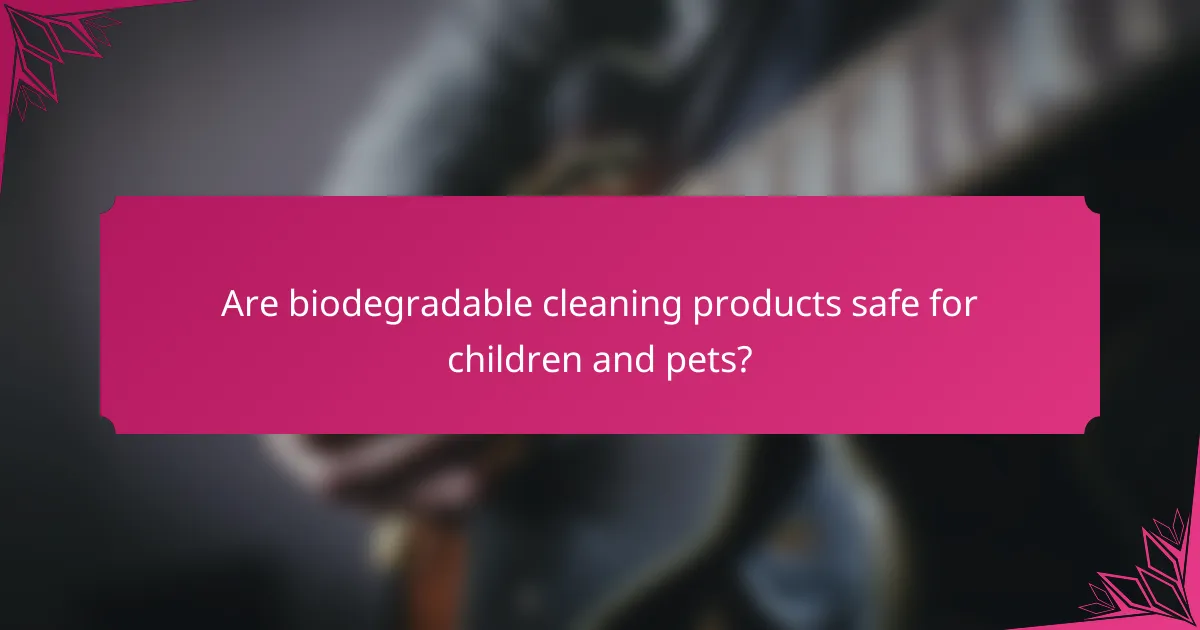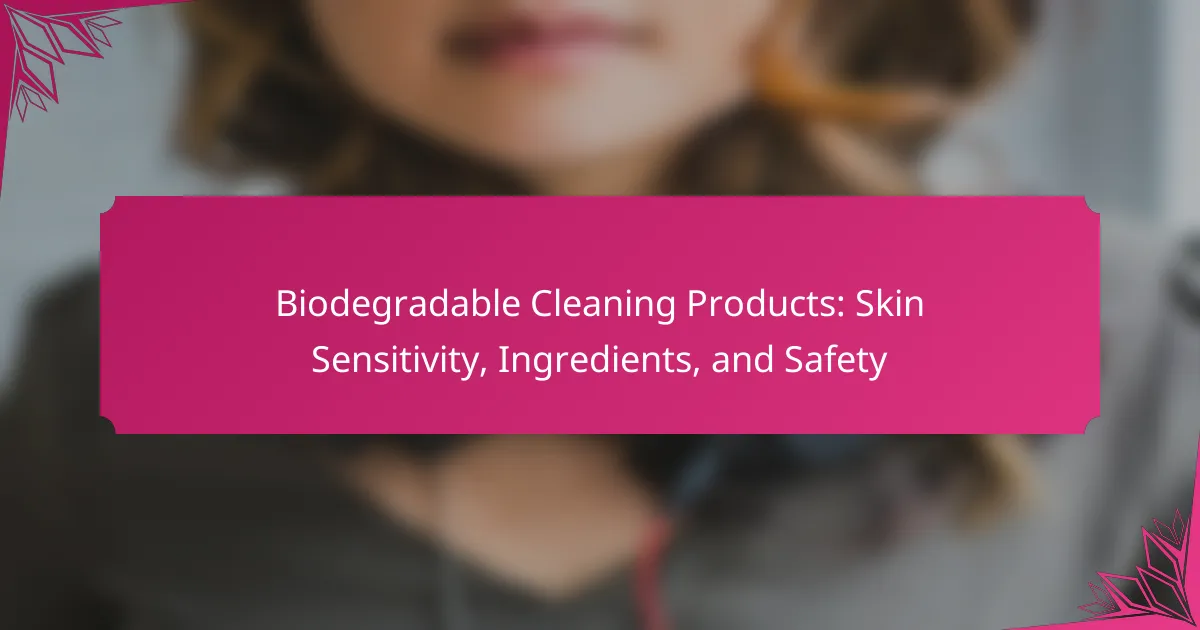Biodegradable cleaning products offer a safer alternative for those with sensitive skin, as they are typically formulated with milder ingredients that reduce the risk of irritation. By choosing products free from harsh chemicals and synthetic fragrances, consumers can effectively clean their homes while prioritizing skin health and environmental sustainability. It’s essential to look for plant-based components and non-toxic preservatives to ensure both effectiveness and safety.

What are the best biodegradable cleaning products for sensitive skin?
The best biodegradable cleaning products for sensitive skin are formulated to minimize irritation while effectively cleaning surfaces. Look for products that are free from harsh chemicals and fragrances, as these can often trigger skin sensitivities.
Seventh Generation Free & Clear
Seventh Generation Free & Clear is a popular choice for those with sensitive skin due to its hypoallergenic formula. This cleaner is free of dyes and fragrances, making it less likely to cause irritation.
It effectively tackles dirt and grime while being safe for both your skin and the environment. When using this product, ensure proper ventilation and consider wearing gloves if you have particularly sensitive skin.
Method All-Purpose Cleaner
Method All-Purpose Cleaner is another excellent option for sensitive skin, as it is made with plant-based ingredients and is biodegradable. This cleaner comes in various scents, but the unscented version is ideal for those who prefer to avoid fragrances.
Its non-toxic formula provides effective cleaning power without the harsh chemicals found in many conventional cleaners. Always test a small area first to ensure compatibility with your surfaces.
Mrs. Meyer’s Clean Day Lavender
Mrs. Meyer’s Clean Day Lavender cleaner is well-regarded for its gentle yet effective cleaning properties. While it contains essential oils for fragrance, it is still considered safe for sensitive skin, especially in the lavender scent, known for its calming properties.
When using this product, be mindful of any potential allergies to essential oils. It’s advisable to rinse surfaces thoroughly after cleaning to minimize any residue that may cause irritation.

How do biodegradable cleaning products affect skin sensitivity?
Biodegradable cleaning products generally have a lower impact on skin sensitivity compared to conventional cleaners. Their formulation often includes milder ingredients that are less likely to cause irritation or allergic reactions.
Lower risk of irritation
Biodegradable cleaners typically use plant-based surfactants and other natural components that are gentler on the skin. This reduces the likelihood of irritation, making them suitable for individuals with sensitive skin. For example, products free from harsh chemicals like sulfates and parabens can significantly decrease skin discomfort.
When selecting biodegradable products, look for those labeled as hypoallergenic or dermatologically tested. These certifications indicate a lower risk of causing skin irritation, which is especially important for frequent users or those with existing skin conditions.
Natural ingredients reduce allergic reactions
Many biodegradable cleaning products contain natural ingredients that are less likely to trigger allergic reactions. Common allergens found in conventional cleaners, such as synthetic fragrances and dyes, are often absent in eco-friendly options. This makes them a safer choice for households with allergy-prone individuals.
To minimize the risk of allergic reactions, consider choosing products that list all ingredients transparently. Familiarizing yourself with common allergens can help you avoid potential skin sensitivities. Additionally, patch testing a small amount of the product on your skin can provide reassurance before full use.

What ingredients should I look for in biodegradable cleaning products?
When selecting biodegradable cleaning products, focus on ingredients that are both effective and gentle on the skin. Look for plant-based components, natural fragrances, and non-toxic preservatives to ensure safety and environmental responsibility.
Plant-based surfactants
Plant-based surfactants are derived from natural sources like coconut or corn, making them effective at breaking down dirt and grease without harmful chemicals. These surfactants are generally milder on the skin compared to synthetic alternatives, reducing the risk of irritation.
Common examples include decyl glucoside and sodium coco-sulfate. When choosing products, check for labels that highlight these ingredients to ensure you are opting for safer cleaning solutions.
Essential oils for fragrance
Essential oils provide natural fragrances in biodegradable cleaning products, offering pleasant scents without synthetic additives. Oils like lavender, lemon, and tea tree not only enhance the aroma but also possess antibacterial properties, adding an extra layer of cleaning power.
When selecting products, ensure that the essential oils used are 100% pure and derived from reputable sources. This helps avoid potential allergens and ensures a more natural cleaning experience.
Non-toxic preservatives
Non-toxic preservatives are essential for extending the shelf life of biodegradable cleaning products while maintaining safety. Ingredients like potassium sorbate and sodium benzoate are commonly used and are generally recognized as safe for use in household products.
Always look for products that specify the use of non-toxic preservatives to avoid exposure to harmful chemicals. This is especially important for households with children or individuals with skin sensitivities.

Are biodegradable cleaning products safe for children and pets?
Biodegradable cleaning products are generally safe for children and pets when used correctly. However, it’s essential to choose products specifically formulated to minimize risks and to follow usage instructions carefully.
Generally safe with proper use
When used as directed, biodegradable cleaning products pose minimal risk to children and pets. These products are designed to break down naturally, reducing harmful residues in the environment. Always ensure that the area is well-ventilated during cleaning and avoid allowing children or pets to come into contact with wet surfaces until they are completely dry.
It’s also wise to store cleaning products out of reach of children and pets to prevent accidental ingestion. Consider using child-proof locks on cabinets where these products are kept.
Look for child-safe certifications
To ensure safety, look for biodegradable cleaning products that carry child-safe certifications. These certifications indicate that the products have been tested for safety and are less likely to cause harm if ingested or if they come into contact with skin. Common certifications include those from organizations like the EPA’s Safer Choice program.
Additionally, check the ingredient list for non-toxic components. Avoid products that contain harsh chemicals or fragrances, as these can irritate sensitive skin or respiratory systems in both children and pets.

What are the environmental benefits of biodegradable cleaning products?
Biodegradable cleaning products offer significant environmental benefits by breaking down naturally and reducing harmful waste. They help minimize pollution and support sustainable practices, making them a better choice for eco-conscious consumers.
Reduced pollution in waterways
Biodegradable cleaning products are designed to decompose into non-toxic substances, which helps prevent harmful chemicals from entering waterways. Traditional cleaners often contain phosphates and other pollutants that can disrupt aquatic ecosystems, while biodegradable options mitigate this risk.
When these products are used and disposed of properly, they contribute to cleaner rivers and lakes, supporting wildlife and preserving natural habitats. Choosing biodegradable cleaners can significantly reduce the chemical load on local water systems.
Lower carbon footprint
Using biodegradable cleaning products can lead to a lower carbon footprint compared to conventional cleaners. Many biodegradable options are made from renewable resources, which typically require less energy to produce and transport.
Additionally, the manufacturing processes for these products often prioritize sustainability, reducing greenhouse gas emissions. By opting for biodegradable cleaners, consumers can contribute to a more sustainable environment and help combat climate change.

How to choose the right biodegradable cleaning product?
Choosing the right biodegradable cleaning product involves evaluating its certifications, ingredients, and safety for skin sensitivity. Look for products that meet recognized environmental standards and check their ingredient lists to ensure they are safe for both your health and the planet.
Check for certifications
Certifications indicate that a biodegradable cleaning product meets specific environmental and safety standards. Look for labels such as EcoLogo, Green Seal, or USDA Biobased, which signify adherence to rigorous testing and sustainability criteria.
These certifications can help you identify products that are genuinely eco-friendly versus those that may simply use green marketing tactics. Always verify the credibility of the certification body to ensure its legitimacy.
Read ingredient labels
Reading ingredient labels is crucial for understanding what’s in your biodegradable cleaning product. Look for natural ingredients like plant-based surfactants and avoid harsh chemicals such as phosphates, parabens, and synthetic fragrances that can irritate the skin.
Familiarize yourself with common harmful ingredients to better assess products. If possible, choose items with short ingredient lists, as these often indicate fewer synthetic additives. Consider testing products on a small skin area to check for sensitivity before full use.
